Introduction
Renewable energy projects are increasingly recognized as vital components in the transition to a sustainable energy future. However, the success of these projects hinges on a multitude of factors, with land acquisition and management playing a critical role. This article delves into the intricacies of land requirements for different types of renewable energy sources, such as solar, wind, and bioenergy, and the unique challenges posed by each.
It explores how geospatial analytics can aid in identifying suitable sites, the importance of community engagement and social acceptance, and the necessity of navigating regulatory and environmental constraints. Furthermore, the discussion extends to leveraging advanced technologies for site selection, the role of financial incentives and land co-sharing models, and the future of land services in renewable energy development. By comprehensively addressing these elements, the article provides a thorough understanding of the complexities and opportunities in the land acquisition process for renewable energy projects.
Understanding Land Requirements and Challenges
'The space needs for renewable energy initiatives vary significantly based on whether the energy source is solar, wind, or bioenergy.'. Every category of undertaking requires unique space, terrain, and closeness to current infrastructure. For instance, solar farms typically need large, flat expanses of terrain, while wind farms are better suited to areas with consistent wind patterns and fewer obstructions. 'Bioenergy initiatives often need areas that can sustain biomass production or current agricultural space.'.
Challenges in acquiring suitable property arise from limited availability, competing uses, and the necessity to comply with local zoning regulations and land-use policies. A comprehensive understanding of these requirements is crucial for developers to navigate the complexities of land acquisition effectively. For instance, the state of Colorado has been proactive in tackling these issues through legislation like SB24-212, which seeks to enhance sustainable resource siting by involving local governments and stakeholders in the decision-making process. This partnership aids in simplifying the authorization and location procedures, ensuring that sustainable initiatives can progress without unwarranted holdups while also balancing conservation and community objectives.
Furthermore, initiatives such as the Advanced Distribution Management System test bed provide utilities and industry participants a sandbox environment to simulate planned investments and deployments, further assisting in the effective management of sustainable projects. 'Additionally, research efforts are underway to explore the harmonious coexistence of solar farms with agricultural activities, ensuring that soil quality is maintained or even improved post-development.'.
'These cooperative and inventive methods are crucial for addressing the difficulties related to securing areas for sustainable resources, ultimately aiding in a more viable and effective power landscape.'.
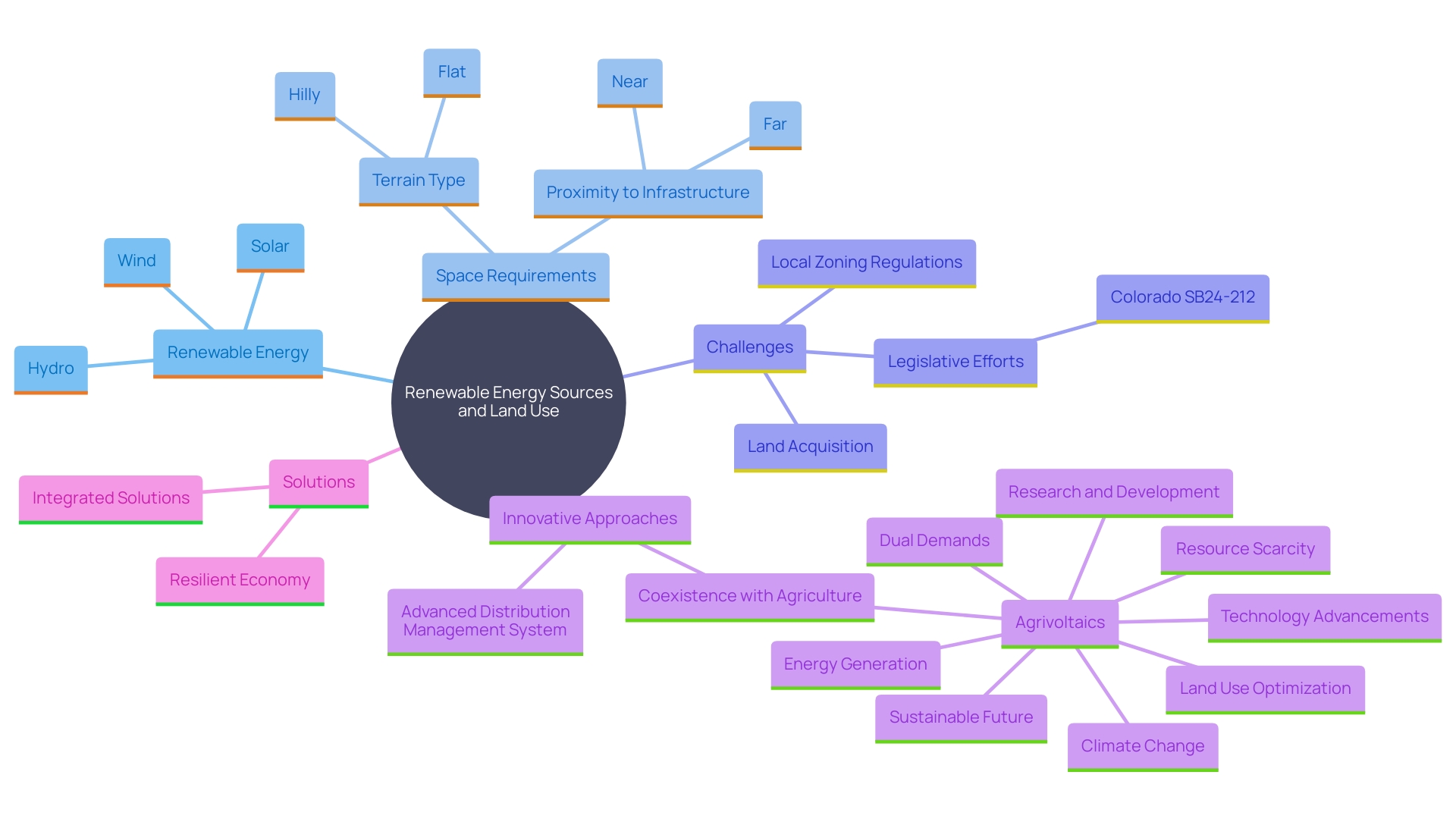
The Role of Geospatial Analytics in Land Identification
Geospatial analytics is essential in identifying appropriate areas for renewable energy projects. 'Using Geographic Information Systems (GIS) and other spatial analysis tools, developers can assess multiple factors such as topography, usage of terrain, environmental constraints, and closeness to transmission lines.'. These technologies enable a more informed decision-making process, facilitating efficient mapping of potential sites and thorough evaluation of suitability before entering negotiations.
'The significance of geospatial data in property acquisition is highlighted by platforms like Acres, which offer interactive GIS layers, historic imagery, and various indexes including crop history and soil maps.'. This allows stakeholders to assess land value, identify potential risks, and explore historical land use effectively. Moreover, the dynamic nature of geospatial data, as provided by sources like the Bureau of Land Management (BLM), necessitates careful consideration of metadata to ensure accuracy and completeness.
Real-world applications demonstrate the power of geospatial analytics. For instance, wind farms in Texas' High Plains region have the capacity to produce enough power to supply 9 million homes. However, the challenge of insufficient transmission networks highlights the need for meticulous site evaluation and planning. As a result, geospatial analysis not only assists in location selection but also in tackling logistical issues, thus improving the viability and success of sustainable initiatives.
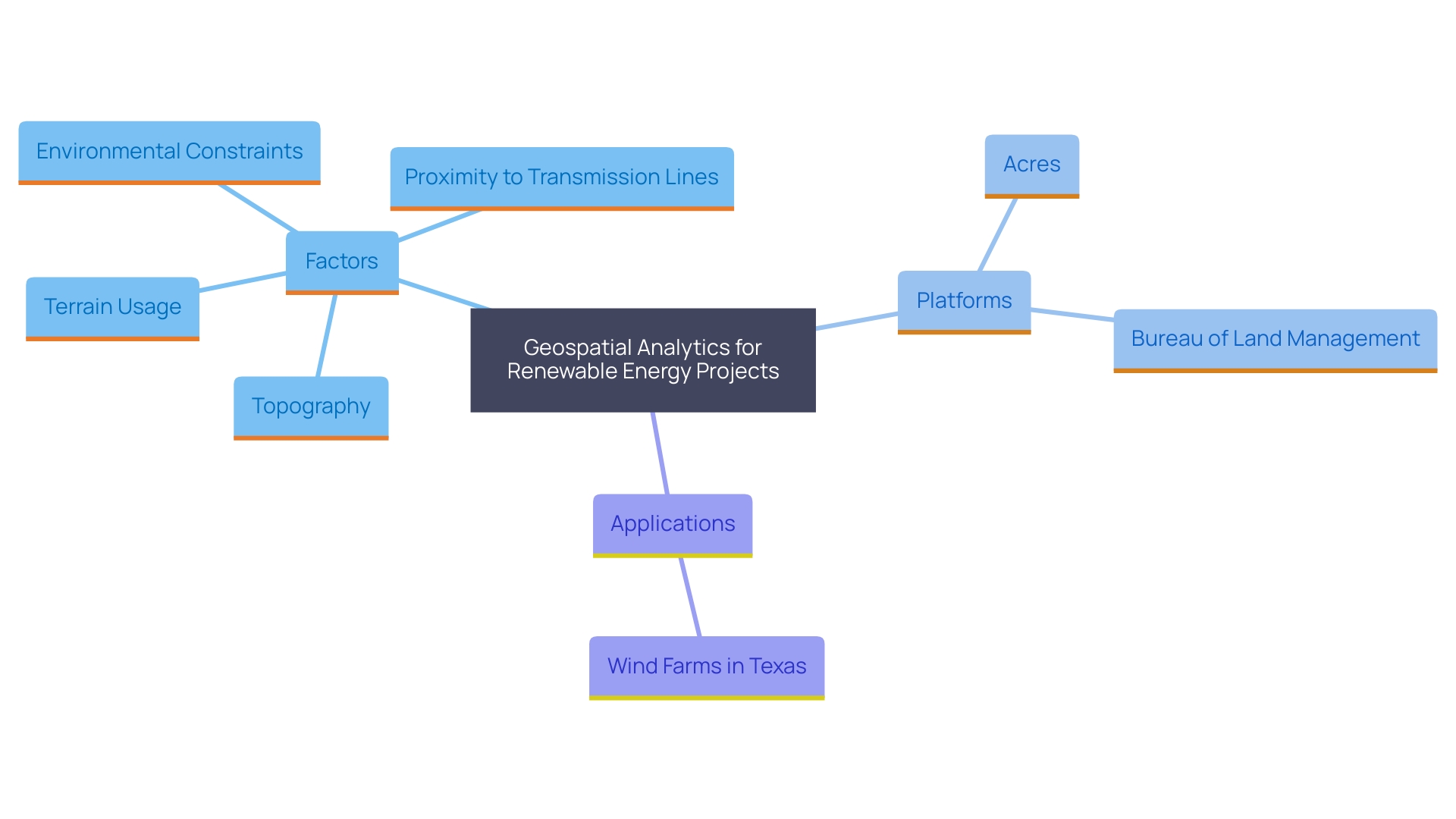
Importance of Community Engagement and Social Acceptance
Community involvement plays a crucial part in the effective acquisition and management of land for sustainable initiatives. Building strong relationships with local stakeholders fosters trust and can lead to smoother negotiations. Addressing community concerns and highlighting the benefits of renewable energy, such as job creation and environmental sustainability, is essential. For instance, the RevoluSolar initiative in Brazil has shown that involving community members through co-operative models and training programs can lead to significant benefits, including reduced electricity bills and economic growth. Similarly, RESEX’s initiative in the Brazilian Amazon demonstrated how solar PV systems managed by communities can boost local economies, exemplified by a 160% increase in freshwater fish production.
Social acceptance is a significant factor influencing timelines and outcomes. According to a survey by Lawrence Berkeley National Laboratory, community opposition and local ordinances are among the top reasons for delays and cancellations of wind and solar initiatives. This opposition often stems from concerns about the impact on quality of life and property values, as evidenced by studies showing proximity to wind turbines can affect residential property values. Anticipatory dialogue and engagement initiatives are essential to address these issues and guarantee the seamless execution of sustainable initiatives.
Furthermore, initiatives such as the U.S. Offshore Wind Power Hub, which offers real-time monitoring of offshore wind activities, demonstrate the significance of openness and community participation. By keeping communities informed and engaged, sustainable initiatives can gain the necessary backing to progress effectively. This method not only tackles immediate issues but also fosters long-term backing for sustainable power solutions.
Navigating Regulatory and Environmental Constraints
'Navigating the regulatory landscape is essential for successful property acquisition in renewable energy initiatives.'. Each jurisdiction has its own set of regulations regarding land use, environmental protection, and approvals for initiatives. Thorough due diligence is essential for companies to understand these regulations and ensure compliance throughout the project lifecycle. Environmental assessments are often required to evaluate potential impacts on wildlife, habitats, and ecosystems, necessitating collaboration with environmental agencies and stakeholders.
In Colorado, for example, Senate Bill 24-212 seeks to enhance sustainable resource siting by tackling existing obstacles and recognizing possibilities. This law highlights the importance of consensus-building among local governments, the renewable energy industry, wildlife, and conservation organizations. County commissioners and local planners are pivotal in making siting and permitting decisions, though they often face challenges such as limited staff and technical capacity. According to a survey by Lawrence Berkeley National Laboratory, local opposition and restrictive zoning ordinances are leading causes of cancellations and delays nationwide.
The Biden-Harris Administration has implemented measures to streamline environmental reviews, cutting the median time for agencies to complete environmental impact statements by 16%. The Department of Energy (DOE) has reduced environmental review timelines for transmission initiatives through the Coordinated Interagency Authorization and Permits (CITAP) program. The Department of the Interior has also allowed more than twice as many clean power projects on public lands compared to the previous administration, contributing to supplying over 12 million homes.
A new report by the U.S. Department of Energy highlights the variety of clean power siting policies throughout the nation. Public opinion surveys show significant backing for sustainable sources, and federal incentives through the Inflation Reduction Act seek to sustain this momentum. However, the complexity of siting and permitting processes remains a challenge. The report's interactive map provides detailed information on each state's policies, aiding lawmakers in understanding this complex landscape.
Assessing the status of sustainable power deployment through fact-based analysis can assist local authorities in becoming effective partners in sustainable projects. By providing input to state agencies and leveraging resources from laws like SB24-212, communities can make informed siting and permitting decisions. The partnership among sustainable power creators, state, and local authorities is essential for promoting clean power while balancing conservation and community objectives.
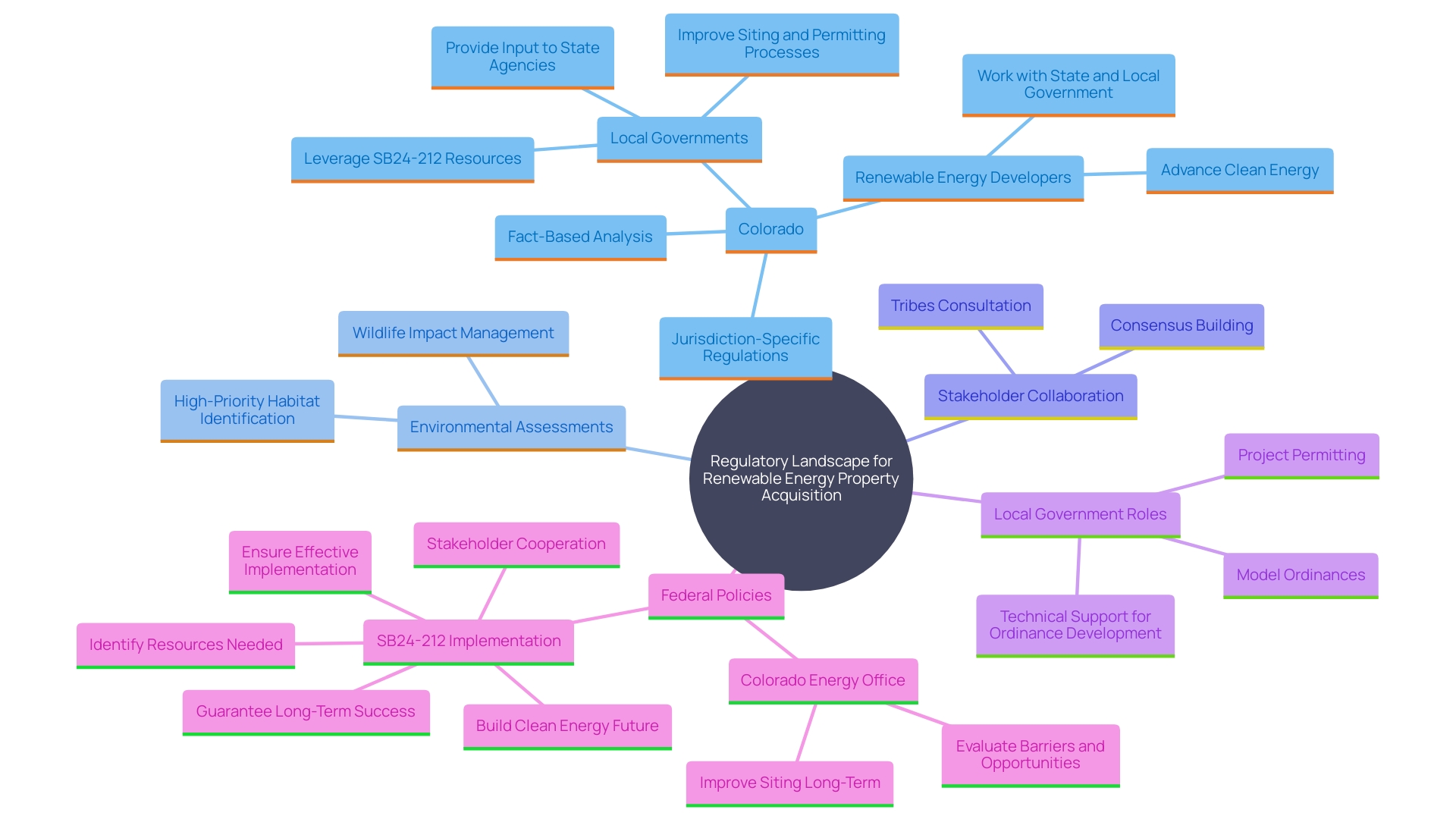
Leveraging Technology for Site Selection and Land Management
'Technological advancements are revolutionizing site selection and property management in the renewable energy sector.'. AI-driven applications and sophisticated data analysis instruments greatly improve the effectiveness and precision of title research, terrain mapping, and site evaluations. For example, the company Acres has leveraged these technologies to become a market leader, providing real estate professionals with tools that streamline operations and reduce risks associated with land acquisition. As Phil George, CFO at The Renewables Infrastructure Group, noted, RES demonstrated exemplary technical expertise and adaptability, overcoming unique challenges and ensuring long-term performance. These technologies provide extensive data insights, guiding strategic decision-making and encouraging the advancement of successful clean power initiatives worldwide.
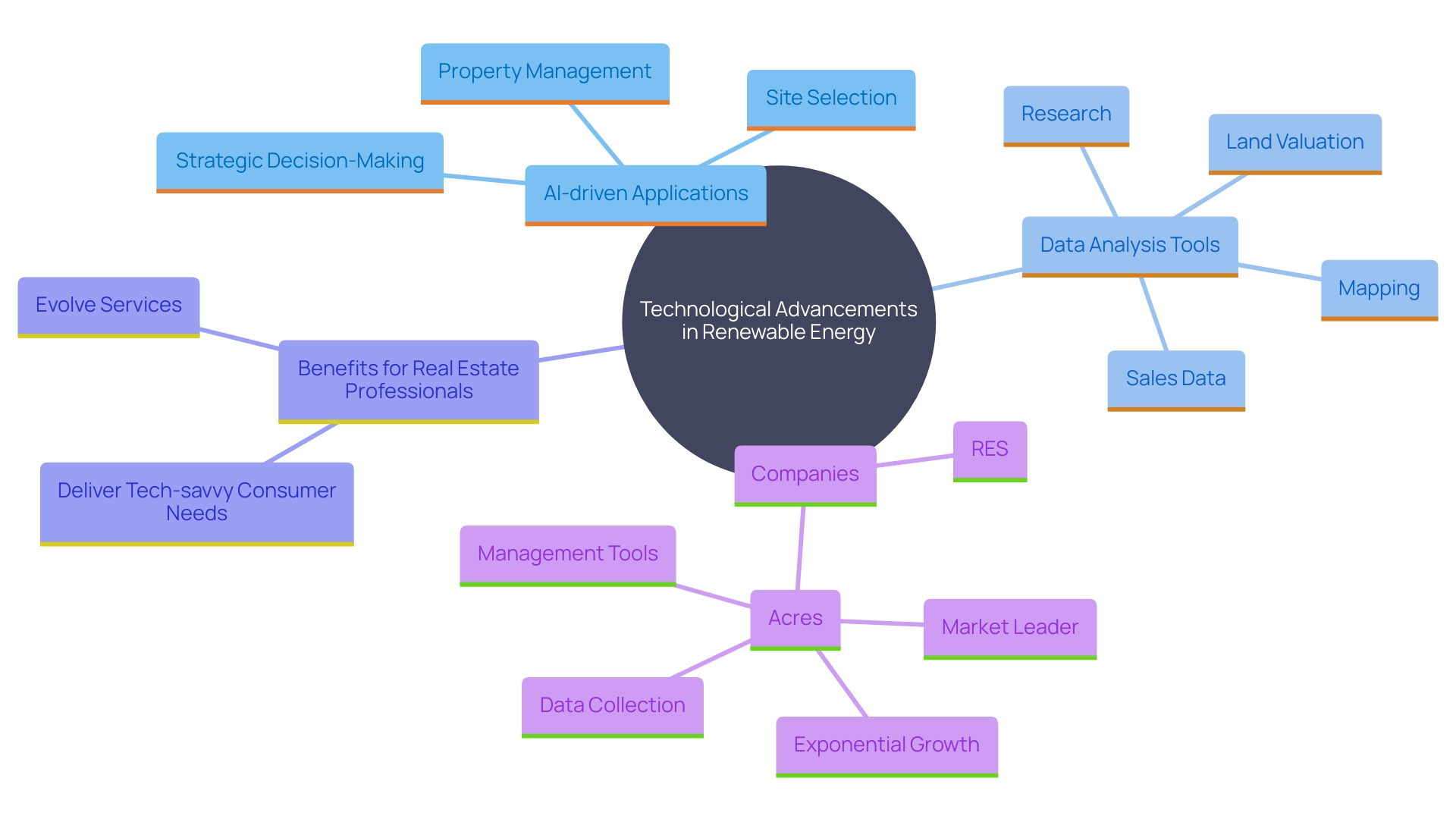
Financial Incentives and Land Co-Sharing Models
Financial incentives are essential in making sustainable power initiatives economically feasible. Governments and local authorities often provide grants, tax credits, and subsidies to encourage the development of sustainable resources. For example, the National Recovery and Resilience Plan (NRRP) endorsed by the EU in July 2022, provided a budget boost of 785 million euros to assist investments in renewable sources within the agricultural sector. Such schemes aim to mitigate financial risks for developers and investors, thereby fostering large-scale agrivoltaics projects. This method not only promotes progress in technology but also enhances the efficiency of resource utilization, tackling important problems connected to power, agriculture, and climate change.
Furthermore, co-sharing models for territory can significantly enhance use efficiency. By combining various endeavors or land applications, these models offer financial advantages to landowners while promoting sustainable power initiatives. The POWER UP pilot cities, which focus on solar and wind projects, serve as practical examples. These pilots provide valuable insights into the economic, technical, and legal aspects of renewable power installations, guiding local administrations through the complex processes involved.
Furthermore, investment in agrivoltaics is gaining momentum as it fulfills the dual needs for food and power. By maximizing use efficiency of space and promoting innovative practices, agrivoltaics supports a resilient and sustainable global economy. Recent research indicates that development payments to farmers vary by region, with the Plains region having the largest share of farm producers receiving payments for on-farm power production. This emphasizes the considerable financial advantages that can be utilized through effective territory management and sustainable power integration.
In conclusion, financial incentives, co-sharing models, and agrivoltaics represent promising pathways toward a more sustainable future. By supporting research and development, these initiatives can address the pressing challenges of climate change and resource scarcity, ultimately fostering a resilient and sustainable global economy.
The Future of Land Services in Renewable Energy Development
'The outlook for property services in sustainable resource development will be influenced by the incorporation of cutting-edge technologies, strong stakeholder involvement, and a dedication to environmental responsibility.'. As renewable energy projects grow, the need for effective property acquisition strategies will intensify. According to the LAND-at-scale program, promoting fair and just tenure security and providing access to property and natural resources are essential for sustainable development. This initiative emphasizes the significance of enhancing successful pilots and backing innovative interventions, ensuring effective use of resources and minimizing conflicts.
Collaboration among private sectors, government agencies, and local communities will be essential. Such partnerships can streamline the identification of suitable terrain for infrastructure, address property tenure issues, and include local communities in decision-making processes through participatory property registration programs. The World Bank's latest initiative, a USD 50 million regional platform, seeks to improve technical assistance for clean power endeavors, speeding up access to sustainable resources in Eastern and Southern Africa.
The financial aspect is also pivotal. The cost of climate change adaptation in developing countries could reach up to $390 billion this decade, far exceeding the current investment range of $20–25 billion per year. This financial gap highlights the necessity for increased private financing in climate adaptation efforts. Effective land access systems enable both governments and private organizations to invest in sustainable resources and larger infrastructure initiatives, promoting climate-conscious development.
Ultimately, the integration of diverse perspectives and comprehensive data from various stakeholders will be crucial in assessing the environmental and social sustainability of renewables. A holistic approach is necessary to build a trusted, common understanding of the energy transition, ensuring that renewable energy projects are both effective and equitable.
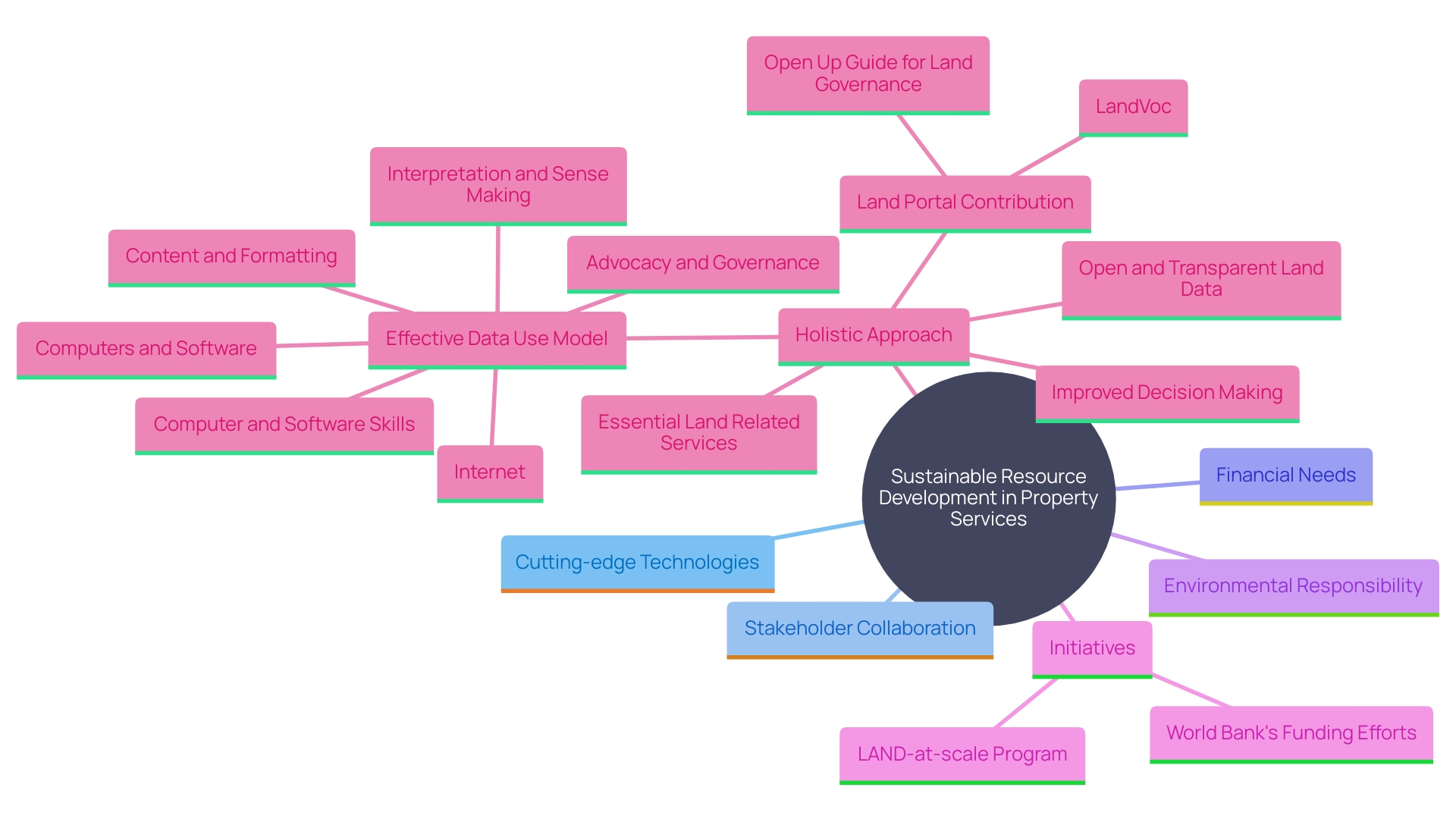
Conclusion
The complexities surrounding land acquisition for renewable energy projects are multifaceted, encompassing diverse energy sources such as solar, wind, and bioenergy. Each type of project presents unique land requirements and challenges, necessitating a thorough understanding of local regulations, environmental considerations, and community dynamics. Successful navigation of these factors is essential for fostering a sustainable energy future.
Geospatial analytics plays a pivotal role in site selection, enabling developers to assess potential locations based on various criteria, including topography and environmental constraints. This data-driven approach facilitates informed decision-making, reducing risks associated with land acquisition. Additionally, community engagement and social acceptance are critical components that can significantly influence project outcomes.
By fostering transparent communication and addressing local concerns, stakeholders can build trust and support for renewable initiatives.
Regulatory frameworks and environmental assessments are equally important in the land acquisition process. A clear understanding of local laws and proactive collaboration with relevant agencies can streamline the permitting process, ultimately enhancing project viability. Furthermore, technological advancements and financial incentives, such as grants and co-sharing models, are instrumental in optimizing land use and promoting innovative solutions like agrivoltaics.
Looking ahead, the future of land services in renewable energy development hinges on collaboration among various stakeholders, including private entities, government agencies, and local communities. By prioritizing sustainability and equitable access to resources, these partnerships can facilitate the effective implementation of renewable energy projects. As the demand for clean energy continues to grow, a comprehensive and inclusive approach will be vital in overcoming the challenges associated with land acquisition, ensuring a resilient and sustainable energy landscape for generations to come.




